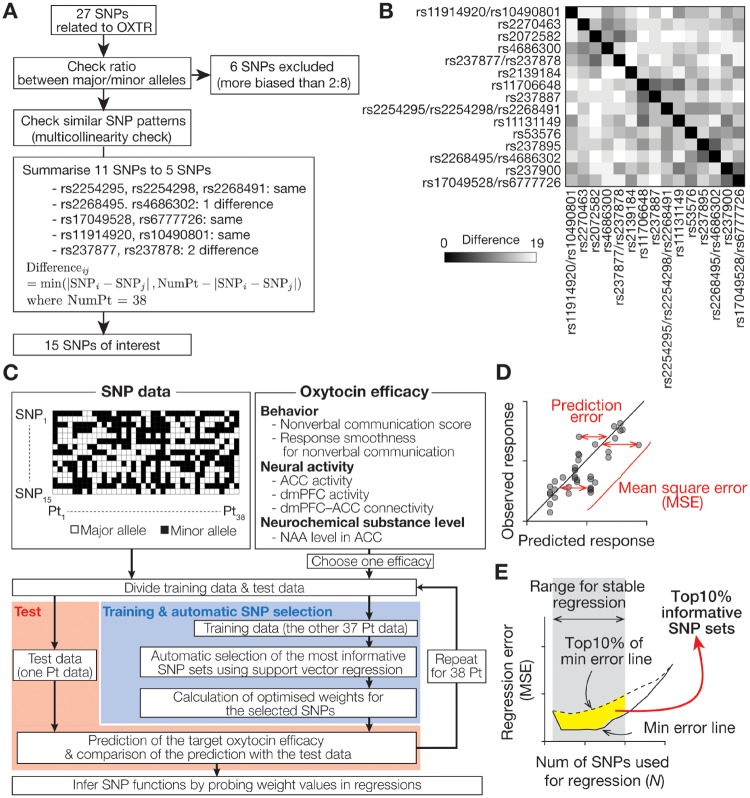Fig. 1.
(A) Selection of SNPs of interest. Based on an established database (Affymetrix Genome-Wide Human SNP Array 6.0) and previous studies (Yamasue, 2013; LoParo and Waldman, 2015), 27 OXTR SNPs were identified for 38 participants with ASD (Supplementary Table 1). First, six SNPs were excluded because of their unbalanced ratios between their major and minor alleles across participants (more biased than 2:8), which could cause inaccurate machine-learning-based analysis. This 2:8 threshold is more conservative than that in previous literature (Johnson et al., 2009; Watanabe et al., 2011). Second, we examined multicollinearity between the remaining 21 SNPs, and 11 SNPs were summarized to five patterns. The patterns of rs2268495 and rs4686302 were summarized to that of rs2268495 because the rs2268495 pattern was less biased than the rs4686302 pattern. Using this logic, the patterns of rs237877 and rs237878 were summarized to that of rs237878. Finally, 15 OXTR SNPs were selected (Table 1). (B) Difference in across-participant SNP patterns. The remaining 15 OXTR SNPs showed ≥ 7 differences from each other, which is supposed to assure sufficient independency of these SNP patterns for the following regression analysis. (C–E) Analysis procedure. Using the 15 OXTR SNPs, we performed machine-learning-based regression analyses to determine specific SNP sets with sufficient information to predict behavioral and neural oxytocin efficacy, which had been measured in our previous trials (Watanabe et al., 2014a; Aoki et al., 2015). Six types of oxytocin efficacy was defined as (i) non-verbal communication score = increased number of NVJ (oxytocin–placebo); (ii) response smoothness = decreased reaction time for NVJ (placebo–oxytocin); (iii, iv) ACC/dmPFC activity = increased brain activity for NVJ in ACC/dmPFC (oxytocin–placebo; ACC, anterior cingulate cortex; dmPFC, dorsomedial prefrontal cortex); (v) dmPFC–ACC connectivity = increased NVJ-specific functional connectivity from dmPFC to ACC (oxytocin–placebo); (vi) NAA level in ACC = increased level of NAA in ACC (oxytocin–placebo).; NAA, N-acetylaspartate. For each of the six types of oxytocin response, we conducted machine-learning-based automatic selections of the most informative SNP sets, and examined its predictability using an independent test dataset. Briefly, we ranked SNPs based on MSEs of the regressions using them (panel D), and extracted the most informative SNPs based on the probability of each SNP appearing in top 10% least MSE SNP groups (panel E; see Supplementary Figure S1 for details).

